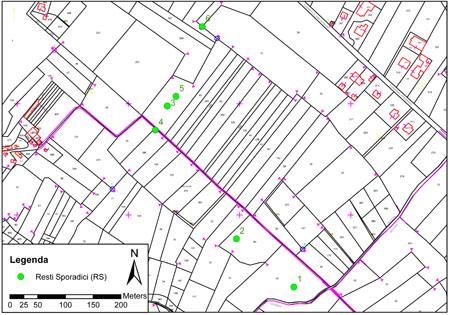Introduction
The archaeological area of Interamna Lirenas presents few standing archaeological remains. This is certainly due to the millenary spoliation process which must have interested the settlement area following its abandonment at the end of Antiquity. In fact, architectural remains (e.g. capitals, columns and thresholds fragments) and inscriptions are to be found scattered across various farms nearby (e.g. Masseria Termine, Masseria Cardillo, Masseria Morra). Unfortunately, such an unavoidable decay process has been worsened and complicated by the much more recent introduction of mechanised agriculture which has deeply affected still buried archaeology.

Fig.1: Distribution of Sporadic Remains (RS) in the urban area of Interamna Lirenas (on Cadastrial Map of the Comune di Pignataro Interamna – Fogli 15 e 22)
Results
Despite the acknowledged existence of standing archaeological remains, their localisation is rather approximate and their recording generally poor. In light of this and of future possible developments, we have carried out a preliminary exploration of the archaeological area (and beyond) and we have started an actual census of such Resti Sporadici (‘Sporadic Remains’) [RS 1-7], involving description, recording and georeferencing by way of a GPS receiver. In the urban area (Figure 1) we therefore recorded:
- RS 1 standing remains of a cistern in opus caementicium with traces of cocciopesto;
- RS 2 standing remains of a cistern in opus caementicium;
- RS 3 standing remains of a low wall in opus mixtum (?);
- RS 4 standing remains of a large stone threshold with hinge- and bolt- holes;
- RS 5 standing remains of a low wall in opus caementicium;
- RS 6 standing remains of a round cistern in opus reticulatum (I-II c. AD) and relative aqueduct.
Outside of the urban area we further recorded:
- RS 7 displaced remains (two halves) of a cistern in opus caementicium, with floor in opus spicatum and mouldings in cocciopesto (already identified by the Canadian team coordinated by E.M. Wightman = W354).
Conclusions
For what concerns the urban archaeological area, the fact that cisterns and a threshold are visible suggests a low preservation in terms of standing archaeological features, generally not protruding much beyond ground level – the latter probably at no more than 0.3 m below the surface. Such a character is well explained by the underlying topography (plateau), as such not affected by significant sedimentary increment and rather exposed to erosion along its sloping sides (especially evident in the case of RS 1). The orientation of the surviving structures is especially interesting as they are either perpendicular (cisterns and walls) or parallel (threshold) to the main settlement axis (today a field path).
Except for RS 4 (only recently brought to light), all standing archaeological remains are in a precarious state of preservation. Especially RS 6, certainly the most interesting case, is heavily invaded by arboreal vegetation, whose roots are jeopardising its own structural integrity.
